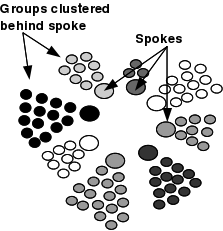The spokescouncil process enables consensus decisions with hundreds and thousands of people. It is used by many groups such as social centres, workers' co-ops, peace and environmental movements (see Case Study: Radical Routes for an example.)
The spokescouncil takes the models for consensus in small groups further by replacing the need for everyone to come together in one meeting with a system of delegate meetings. It is an effective way of allowing all members of a large group to actively participate.
If you are unfamiliar with the basics of consensus you may wish to take a look at our guide on consensus decision making first.
In this process the whole group breaks up into smaller groups who then communicate with each other through 'spokes' (also called delegates or reps/representatives). Small groups could, for example, be based on work teams within a business, local groups within a national network or affinity groups within a mass action, or be a random split.
People in each small group discuss the issue(s) to come up with concerns and ideas. A small group may develop a preferred proposal or come up with a range of ideas.
Each group sends a delegate (or 'spoke') to the spokescouncil meeting, where all delegates present the breadth of ideas and concerns of their groups. The spokes then come up with proposals that they think might be acceptable to everyone and take these back to groups for more discussion and amendments. This process is repeated until agreement is reached. The power to make decisions remains with all members.
The remit of the spoke needs to be clearly defined for a spokescouncil to work effectively. The task of the spoke is primarily to feed back information between the small group and the council. The spoke needs to act as a voice for everyone within the small group, communicating the breadth of collective thought rather than their own personal point of view. Generally spokes do not make decisions for their group, but will always check back for agreement before a decision is finalised. However, some small groups might also empower their spoke to take decisions within agreed parameters.
Being the spoke is not easy – it carries a lot of responsibility. You might like to rotate the role of spoke from meeting to meeting, or agenda item to agenda item. It also helps to have two spokes, one of them presenting the viewpoints and proposals from their small group, the other to take notes of what other groups have to say. This helps to ensure that ideas don't get lost or misrepresented in the transmission between small groups and the spokescouncil. Spokescouncils require good facilitation by a team of at least three facilitators, who work well together and who are skilled at synthesising proposals.
 If all the people involved in making the decisions are together in the same place and the space is big enough, it works well to have groups sitting in a cluster behind their spoke during the spokescouncil. This way, groups can hear what is being discussed and give immediate feedback to their spoke. This can make the spokescouncil more accountable and reduce the need for repeating information (see diagramme on the right).
If all the people involved in making the decisions are together in the same place and the space is big enough, it works well to have groups sitting in a cluster behind their spoke during the spokescouncil. This way, groups can hear what is being discussed and give immediate feedback to their spoke. This can make the spokescouncil more accountable and reduce the need for repeating information (see diagramme on the right).
The spokescouncil model also works for long-distance decision making. Rather than all members of all groups converging in one place to make a decision, groups can discuss the issue at home and then send a spoke to a meeting, which may involve the spokes travelling to meet in person or communication via telephone conferences, chat rooms or online decision-making tools such as loomio. The spokes come back with a proposal that the groups either accept or amend.
In some situations such as mass actions you might have more than 20-40 small groups. In this case you can add more tiers, where each spokescouncil sends a spoke to a second or even third level spokescouncil. This can work for many thousands people, e.g. 9000 people involved in the blockade of a Castor nuclear waste transport in 1997. With this number of people it becomes even more important to think carefully about which decisions need to be made by everyone and which can be left to individual groups. Often the tiered spokescouncil mostly acts as a channel for information and consultation rather than being used for actual decision making.
Radical Routes is a UK wide mutual aid network of around 40 member co-ops. Decisions are made by consensus using a delegates' meeting structure. The network comes together in Business Meetings four times a year to make a variety of decisions, including dealing with proposals by member co-ops to the Radical Routes loan fund.
Each co-op sends a representative to the meeting. An agenda for each meeting is sent out beforehand so that member co-ops can discuss the agenda items, and tell their representative how to respond to proposals in the meeting. Representatives may have a remit of what's OK to agree to, and when they have to go back to their co-op for instruction.
If a new proposal comes up or a proposal is changed significantly over the course of a meeting, it always goes back to the member co-ops for further discussion and approval.
The running of the network is delegated into working groups, such as finance, secretarial and co-op support. Working groups get on with day to day tasks within remits set by the whole network and within agreed budgets. Working groups are accountable to the membership via the business meetings, where they report back on their work.
Below is an example flowchart of a spokescouncil. Exactly how a spokescouncil is structured depends on the group involved. The process outlined here was used for some of the decision-making at the Horizone camp at 2005 G8 in Stirling, where several hundred people were together in one space.
